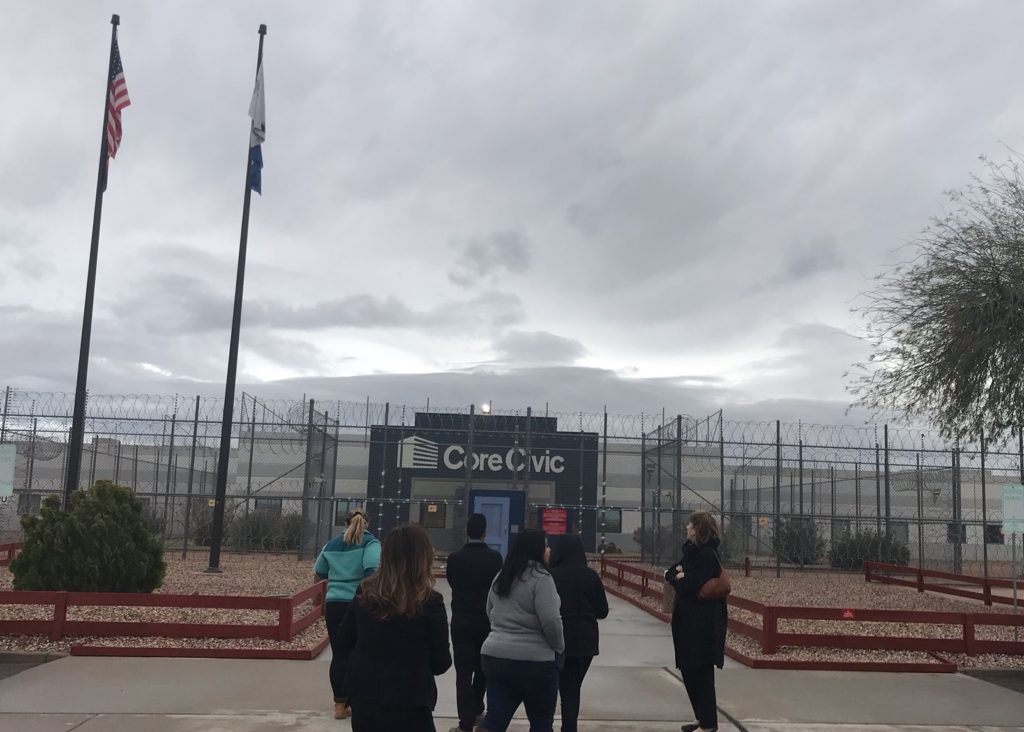In 2019, nine intrepid Santa Clara Law students decided to bypass the traditional spring break of study and relaxation to devote the week to serving detained immigrants. The students traveled to Arizona, with law faculty Lynette Parker, Evangeline Abriel, and Pratheepan “Deep” Gulasekaram, to work for the week with the Florence Immigrant and Refugee Rights Project. Three of the students – Quetzalli Haro, Linette Salcedo, and Keuren Parra Moreno – worked with the Florence Project’s children’s program in Tucson, while the other six – Marili Iturbe Guardarrama, Christina Santora, Thania Lopez, Sharon Morales, Joaquin Torres, and Ozzy Hidalgo Otamendi – worked with the Project’s adult program in Florence. To prepare for the experience, the students went through two days of training on subjects such as removal proceedings, detention and bond, asylum, and special forms of relief for children. They share their experiences in the following blog posts.

Santa Clara Law students and Professor Abriel entering the Florence Detention Center.
Wednesday marked one of the colder days of our time in Arizona. Our day, like the past few days, started early as we headed out at 7:00 am to visit the Florence Correctional Center and the Florence Detention center which are operated by CoreCivic and the federal government, respectively. Since we were staying in Marana, we were some distance away from the facilities but our location also had us close enough to the Florence Project’s office in Tucson, so both our adult and child team could work effectively. Soon after arriving at the Florence Project office in Florence, our now eight-person adult team split into two groups, to make sure we could visit all the facilities. Our work at the facilities then focused on assisting Florence Project staff with Know Your Rights presentations, which gave detainees a brief overview of legal remedies, upcoming court dates, bond hearings; and client individual orientations, where we spoke with individual’s about their particular legal situation to help them identify any potential remedies they might be able to receive.
While we arrived at both facilities early, an issue with proper clearances delayed both our groups’ entries by approximately an hour. A few calls and emails later, we were in the facilities right in time to help the project’s staff with individual orientations. In Florence Detention Center, where I was helping, the presentation took place in a combination of the detention facility cafeteria and nearby outdoor space. While still a detention facility, the layout and cafeteria smell was reminiscent of grade school, in part because they most likely used the same food services. We could not use the cafeteria where we would normally hold interviews when lunchtime was nearing, so our work had to be done outside on a cold and windy day and the restrictive clothing policy made it more difficult to stay warm. The client turnout was substantially lower than the turnout at the La Palma facility, possibly due to policies dictating where new detainees are routed and housed. With a small turnout, we went through the interviews within a couple of hours and out to lunch.
On the recommendation of one of the Florence Project’s excellent staff, we made our way to Jalapeno’s Restaurant in Florence. Although it was a small sit-down restaurant, it had drive-through service like many other peculiar Arizonian restaurants. This marked our second day eating Mexican food, only this time we were joined by Professor Gulasekaram who had joined us to lend support and check out the facilities in Florence. The food was what would be expected of Mexican food in terms of dishes but the team agreed that it was not like Mexican food in California.
After our lunch, we returned to the Florence Project as a team where we spent the rest of our workday working on small research projects, ranging from researching country conditions, to equitable tolling, and the use of videoconference in immigration hearings. The other team’s experience at FCC was much like ours, and also significantly shortened by the clearance issue. Nevertheless, as a whole we were able to help the project by reducing their workload through intakes and research.